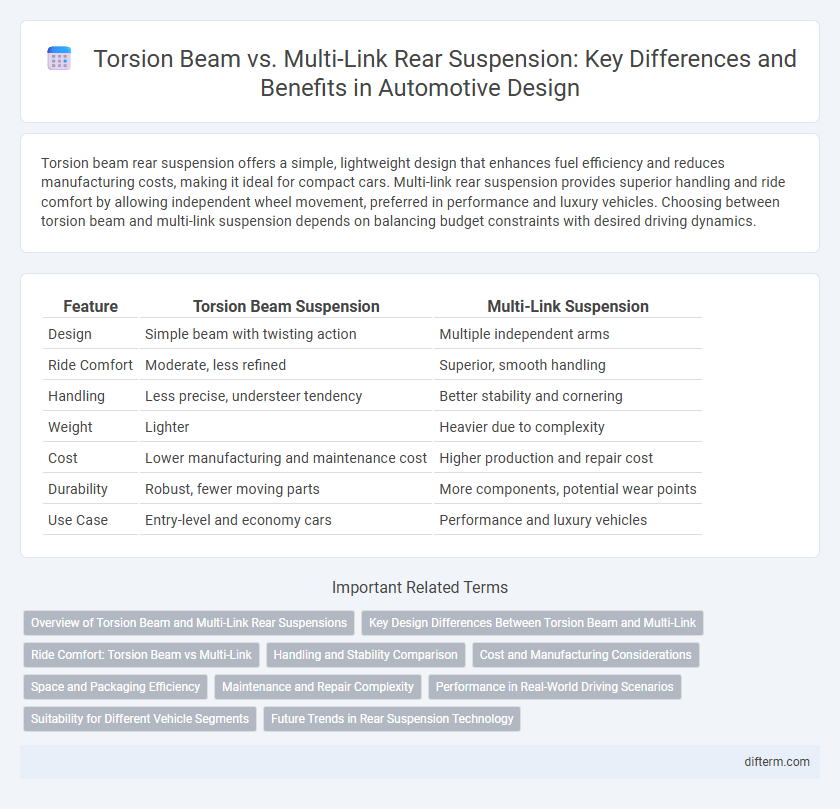Torsion beam rear suspension offers a simple, lightweight design that enhances fuel efficiency and reduces manufacturing costs, making it ideal for compact cars. Multi-link rear suspension provides superior handling and ride comfort by allowing independent wheel movement, preferred in performance and luxury vehicles. Choosing between torsion beam and multi-link suspension depends on balancing budget constraints with desired driving dynamics.
Table of Comparison
| Feature | Torsion Beam Suspension | Multi-Link Suspension |
|---|---|---|
| Design | Simple beam with twisting action | Multiple independent arms |
| Ride Comfort | Moderate, less refined | Superior, smooth handling |
| Handling | Less precise, understeer tendency | Better stability and cornering |
| Weight | Lighter | Heavier due to complexity |
| Cost | Lower manufacturing and maintenance cost | Higher production and repair cost |
| Durability | Robust, fewer moving parts | More components, potential wear points |
| Use Case | Entry-level and economy cars | Performance and luxury vehicles |
Overview of Torsion Beam and Multi-Link Rear Suspensions
Torsion beam rear suspension features a simple, cost-effective design combining a beam and trailing arms that offers compact packaging and reliable performance suitable for economy vehicles. Multi-link rear suspension utilizes multiple arms and links to independently control wheel movement, improving handling, ride comfort, and stability, commonly found in performance and luxury cars. Both systems balance complexity, cost, and dynamic capabilities, with torsion beams favoring affordability and space efficiency while multi-link suspensions enhance driving dynamics and adjustability.
Key Design Differences Between Torsion Beam and Multi-Link
Torsion beam rear suspensions feature a single, solid beam connecting the wheels, providing a compact and cost-effective design with limited independent wheel movement. Multi-link rear suspensions utilize multiple arms and joints, allowing for greater wheel independence, enhanced handling, and improved ride comfort. Key design differences include the torsion beam's simpler structure versus the complex geometry of multi-link systems, impacting manufacturing cost, weight, and vehicle dynamics.
Ride Comfort: Torsion Beam vs Multi-Link
Multi-link rear suspension provides superior ride comfort by allowing independent wheel movement, reducing road vibrations and enhancing handling stability. Torsion beam suspension, while more cost-effective and compact, typically transmits more road shock due to its semi-independent design, resulting in a firmer ride. Automakers often choose multi-link suspension in premium vehicles to optimize comfort and performance on varied road conditions.
Handling and Stability Comparison
Torsion beam rear suspension offers simplicity and compactness, providing moderate handling performance with limited independent wheel movement, which can reduce stability on uneven surfaces. Multi-link rear suspension allows each wheel to move independently, enhancing handling precision and stability by maintaining better tire contact during cornering and rough road conditions. Vehicles equipped with multi-link suspension generally achieve superior grip, improved ride comfort, and enhanced stability compared to torsion beam setups.
Cost and Manufacturing Considerations
Torsion beam rear suspension offers significant cost advantages due to its simpler design and fewer components, which reduce manufacturing complexity and assembly time. Multi-link rear suspension, by contrast, requires more precision engineering and multiple control arms, leading to higher production expenses and increased labor costs. Manufacturers often select torsion beam setups for budget-friendly compact cars, while multi-link systems are reserved for premium models where enhanced handling justifies the elevated cost.
Space and Packaging Efficiency
Torsion beam rear suspension offers superior space and packaging efficiency by occupying less horizontal room and allowing more trunk and interior space, making it ideal for compact and mid-size vehicles. Multi-link rear suspension requires more components and space due to multiple arms and linkages, which can reduce cargo volume but provides enhanced handling and ride comfort. Automakers prioritize torsion beam setups in models where maximizing interior cabin and luggage room is critical without compromising production costs.
Maintenance and Repair Complexity
Torsion beam rear suspension offers simpler maintenance and repair due to fewer components and a more straightforward design, reducing labor time and parts costs. Multi-link rear suspension, with its numerous arms and bushings, demands more frequent inspections and specialized tools for alignment and repairs, increasing service complexity. Repairing multi-link systems often involves higher expenses and longer downtime compared to the torsion beam setup.
Performance in Real-World Driving Scenarios
Torsion beam rear suspension offers a simpler, lighter design that provides decent handling and stability for everyday urban and highway driving. Multi-link rear suspension delivers superior wheel articulation and independent movement, enhancing traction, cornering precision, and ride comfort on uneven roads and spirited driving conditions. Vehicles equipped with multi-link setups often exhibit improved responsiveness and reduced body roll in dynamic real-world scenarios compared to torsion beam systems.
Suitability for Different Vehicle Segments
Torsion beam rear suspension is commonly used in compact and economy vehicles due to its cost-effectiveness, simplicity, and space efficiency, making it ideal for city cars and small hatchbacks. Multi-link rear suspension suits mid-size to luxury vehicles and performance cars that demand superior ride comfort, handling precision, and independent wheel movement for better road grip. Automakers often choose torsion beam setups for budget-friendly models, while premium brands prefer multi-link systems for enhanced driving dynamics and passenger comfort.
Future Trends in Rear Suspension Technology
Future trends in rear suspension technology indicate a shift towards advanced multi-link systems due to their superior ride comfort, handling precision, and adaptability to electric vehicle platforms. Innovations in lightweight materials and active suspension components will enhance multi-link systems' efficiency, enabling dynamic adjustments for varying road conditions and loads. Torsion beam suspensions may persist in compact and cost-sensitive segments, but multi-link setups will dominate as automakers prioritize performance, safety, and integration with autonomous driving technologies.
torsion beam vs multi-link rear suspension Infographic

 difterm.com
difterm.com